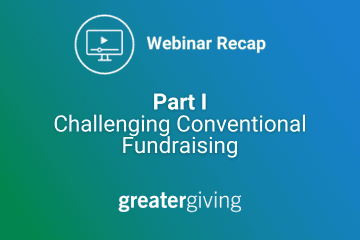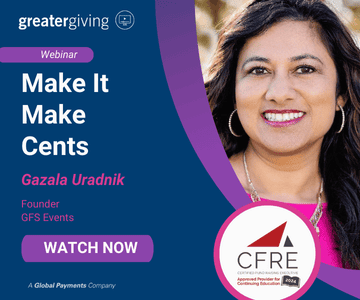
Make it Make Cents: Challenging Conventional Fundraising Wisdom
The first part in a two-part series about challenging conventional fundraising and focusing your efforts on making the most of your revenue potential.
Gazala Uradnik, founder of GFS Events, joined us to talk about event budgeting, revenue producers, and how to make the most of each of your revenue channels. She had tons of practical tips to share, and offered a broader approach to raising more money with the resources you have available. GFS events has planned hundreds of events and raised millions of dollars for nonprofits over the last twelve years.
What makes an event profitable?
Establish purpose
Gazala advises setting goals and objectives at the outset. Knowing what you plan to achieve with your event is critical to holding a strong fundraiser. Make sure everyone involved in the event, from staff to volunteers to vendors, is aligned with your reason. Bring all of your fundraising decisions back to this mission.
Why are you holding your event?
Are you doing it simply because you’ve always done it? Are you celebrating an anniversary, or rebranding? Perhaps your annual event is a big part of your organization’s revenue. Make sure you know what you plan to achieve before you begin.
Analyze your budget
You’re looking for the highest return on investment with your expenses, which might mean making changes you haven’t considered before to bring in a higher ROI.
For example, auctions can be expensive to hold, and some nonprofit organizations think that translates to higher revenue. But that isn’t always the case.
Gazala worked with a nonprofit who spent over 40% of their revenue on expenses to hold a silent and live auction event on a weekday. She suggested they refocus all that item solicitation and procurement time on getting sponsors and pledges prior to the event. After this shift, their model became a two-hour weekday event where guests can network with light food and drink. Then the organization asks for a gift, whether with gift envelopes on a table or with a live paddle raise.
As a result, they raised $210,000, and their revenue to expense ratio was under 20%—nearly half of before. There are other formats out there besides the standard auction fundraiser.
What kind of event are you holding?
Is the event format in-person event, virtual, or hybrid? Will you include an auction? Will you be holding it on a weekend or a weekday? Is this an outdoor community event, or a sit-down dinner?
Organizations are trying new things, sometimes departing from auctions and trying on new approaches that cost less and take up less time. One organization wanted to attract a younger audience of donors, so they created an event where guests moved from room to room, each room representing a pillar of the organization. It had food, drinks, and activities, and then at the end, people were invited back to the main room for dancing. There was a pause in the middle where an intentional ask was made for donations, and then the event quickly returned to the fun.
Do you have A Conventional Fundraising Audience?
Who’s your audience? Are they members of your community, sponsors, or people looking to make an impact directly? Are they new, and looking to make more of a transactional donation?
When planning an event, take into consideration your demographics. For example, an event that caters to older guests might not be a good place to test out mobile bidding. Make sure you’re planning an event for the people who are attending.
Audience development
One misconception that comes up frequently is that you have to increase the number of guests in the room in order to achieve growth from year to year. Gazala tells us that isn’t necessarily true—you could have 800 people in the room, and if only a handful of those people are committed and connected to the cause, then you’ll have a low level of giving.
Recently, an organization changed their big fundraiser to three micro-events that each had about fifty people in attendance. These were inexpensive events that featured just appetizers and wine, and two were at the nonprofit’s office. The development staff worked hard to get pre-event pledges, and together, these three small events raised the same amount as their big event had previously.
It’s not about the number of people, but the hard work of courting that donor commitment before the event.
How to Secure Your Attendance
Maintain communication with your donors and sponsors throughout the year to show them that you value the relationship as more than transactional. Start a volunteer phone bank 3 to 5 months prior to the event, calling to thank donors and sponsors for their support. This is your first touchpoint leading up to the event.
Your second touchpoint is when you invite them to attend the event. Finally, your third touch point is to confirm they’re attending. If they can’t, consider asking for a donation in lieu of attendance. Your fourth touchpoint with the donor is to secure the pre-committed gift for your paddle raise.
Budget
How much do you need to raise to cover your expenses, and what do you need to net at the end? If this is your first event, you won’t have history to work with, so Gazala suggests starting with your desired revenue outcome, then work backwards from there to find an appropriate expense budget. You shouldn’t be using any more than 25-35% of your revenue for expenses.
If this event is established, then plan for a twenty percent increase in revenue from year to year. That’s a healthy amount of growth. Expect your expenses to rise in relationship to your revenue as you bring in more guests and expand your event.
Expenses
“You have to spend money in order to make money, and for your event to be successful,” – Gazala Uradnik
 You don’t want to just spend money anywhere! Here are the critical conventional fundraising expenditures:
You don’t want to just spend money anywhere! Here are the critical conventional fundraising expenditures:
- Invest in a professional auctioneer. Great events can fall apart if it’s a volunteer or board member on stage. This person is responsible for establishing the energy in the room, and is a huge return on your investment.
- Catering. Food and beverage costs are on the rise. Brainstorm ways you could get away with doing less than a big sit-down dinner. Be realistic about how much you can spend per person and choose the type of meal appropriately. (Costs going up)
- Venue. Hotels can be expensive, but they have everything you need, from chairs to linens. A hotel can ease your stress.
- Audio/video. Sound is non-negotiable at GFS because it’s just that critical. But it can also be complicated for organizations to navigate. Establish a budget for your A/V vendor, and be clear with your vendor about what you need.
- Event planner. Event planners can save you money in the end. GFS has saved their clients thousands of dollars thanks to relationships with their vendor partners, and having an event planner on hand can alleviate an immense amount of stress and free up time
Stay tuned in our follow up article, we’ll talk in more detail about individual revenue streams and how to maximize their fundraising potential—and Gazala will even dispel some conventional wisdom about how best to raise the most funds. In the meantime you can watch a recording of the Make It Make Cents webinar for more insights.
